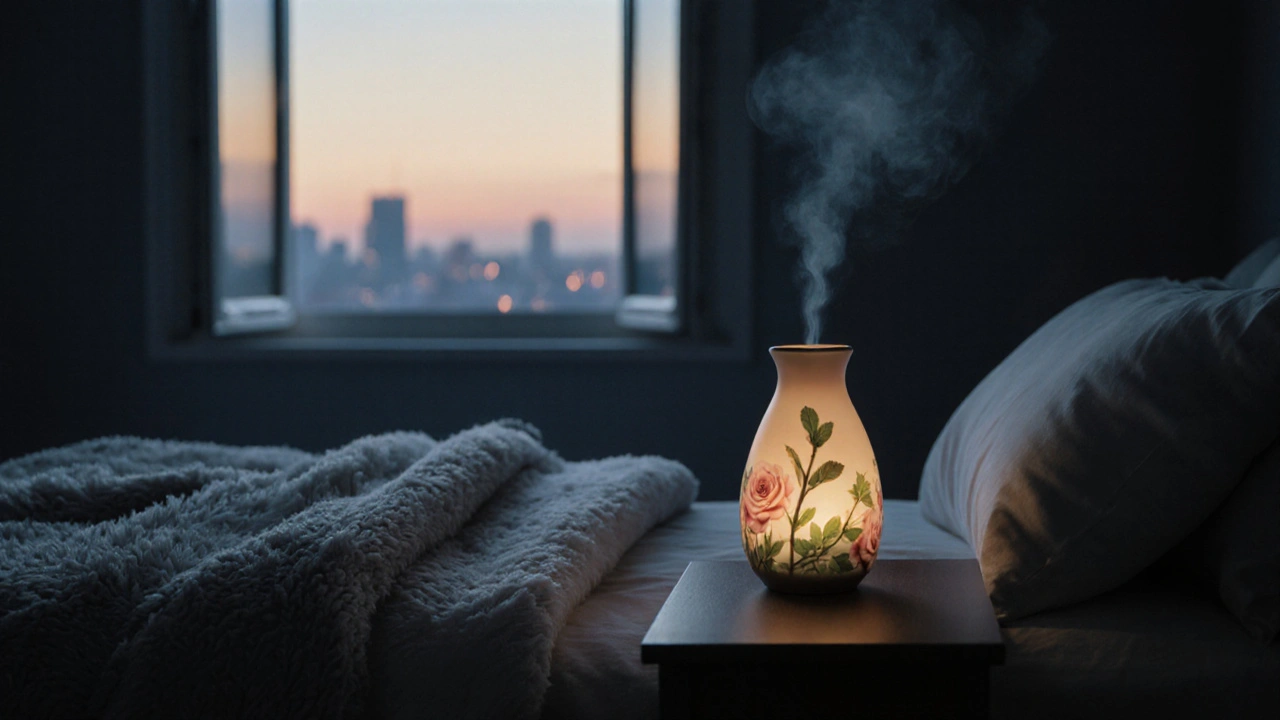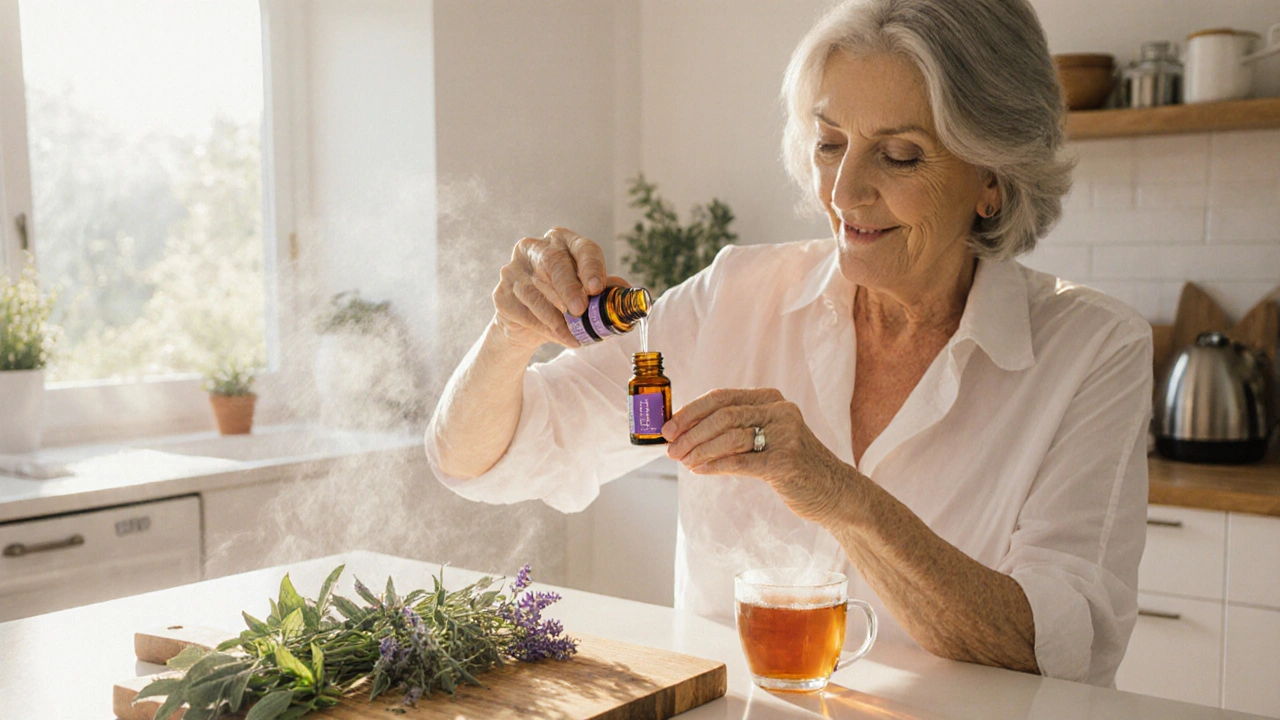Quick Take
- Menopause symptoms like hot flashes and mood swings can be eased with specific essential oils.
- Aromatherapy works by influencing the limbic system and hormone balance.
- Lavender, clary sage, peppermint, geranium, and evening primrose are the top five oils for relief.
- Always dilute essential oils in a carrier oil and test for skin sensitivity.
- Simple DIY recipes let you customize blends for sleep, stress, or temperature control.
When women reach menopause, the body goes through a whirlwind of hormonal shifts that can leave you sweating at night, feeling irritable, or struggling to fall asleep. While hormone therapy is one route, many people turn to nature for a gentler approach. Aromatherapy-using plant‑derived essential oils-has become a go‑to for symptom relief because it’s non‑invasive, inexpensive, and can be tailored to what you need on any given day.
What Is Menopause?
Menopause is the permanent cessation of ovarian function, marking the end of menstrual cycles. It typically occurs between ages 45 and 55 and brings a drop in estrogen and progesterone levels. The hormone dip triggers the classic trio of hot flashes, night sweats, and mood changes, but it also affects sleep quality, skin elasticity, and bone density. Understanding the biology helps you see why a holistic tool like aromatherapy can make a real difference.
How Aromatherapy Helps Menopausal Symptoms
Aromatherapy is the therapeutic use of volatile plant extracts-essential oils-to influence emotional and physiological states. When you inhale a scent, odor molecules travel to the olfactory bulb, which connects directly to the limbic system-the brain area that regulates emotions, stress, and hormone release. Some oils also have anti‑inflammatory or vasodilatory compounds that can calm blood vessels, reducing the intensity of hot flashes.
Top Essential Oils for Hot Flashes and Mood Swings
Below is a quick glance at the five most‑studied oils for menopause relief. Each oil is introduced once with microdata, then revisited in the comparison table.
Lavender oil is renowned for its calming, anxiolytic properties and ability to improve sleep quality.
Clary sage oil is rich in linalyl acetate, which can support estrogen balance and ease hot‑flash frequency.
Peppermint oil is a cooling agent that activates TRPM8 receptors, providing an immediate temperature‑relief sensation.
Geranium oil is thought to stabilize hormonal fluctuations and improve mood through its sweet, floral aroma.
Evening primrose oil is high in gamma‑linolenic acid (GLA), a fatty acid that may reduce night sweats and support skin health.
| Oil | Main Menopause Benefit | Best Application |
|---|---|---|
| Lavender | Reduces anxiety & improves sleep | Diffusion before bedtime or 2‑3 drops on a pillow |
| Clary sage | Balances estrogen, eases hot flashes | Topical (1‑2% dilution) on chest or wrists |
| Peppermint | Instant cooling of sudden heat spikes | Inhalation via hand or diffuser (low concentration) |
| Geranium | Stabilizes mood swings | Diffusion during stressful moments or bath blend |
| Evening primrose | Reduces night sweats, supports skin | Oral supplement (capsule) or carrier‑oil massage |

Using Essential Oils Safely
Safety is the first step before you start blending. Here are the three golden rules:
- Dilute. Mix essential oils with a carrier oil-sweet almond, jojoba, or fractionated coconut-at 1-2% for topical use (about 6‑12 drops per ounce of carrier).
- Patch test. Apply a tiny dab of the diluted blend to the inner forearm and wait 24hours. If redness or itching occurs, discontinue.
- Know contraindications. Pregnant women should avoid clary sage in high doses, and people with epilepsy should steer clear of peppermint in large amounts.
When diffusing, keep the room well‑ventilated and limit sessions to 30‑45 minutes to avoid sensory fatigue.
DIY Aromatherapy Recipes for Menopause Relief
Now that you have the basics, try these three easy blends. Each recipe uses a carrier oil (such as jojoba) as the base.
- Sleep‑Support Pillow Spray - 10ml glass spray bottle, 8drops lavender, 4drops clary sage, 2ml distilled water. Shake before each use and spritz your pillow.
- Cool‑Down Roll‑On - 30ml roll‑on bottle, 5ml carrier oil, 5drops peppermint, 5drops geranium. Apply to pulse points when a hot flash strikes.
- Evening Calm Bath - Add 6drops lavender, 4drops geranium, and 2drops clary sage to a warm bath. Soak for 15minutes to relax muscles and steady hormones.
These recipes let you target sleep, sudden heat, or overall mood, giving you a personalized aromatherapy toolbox.
Choosing Quality Essential Oils
Not all bottles are created equal. Here’s a quick checklist to spot premium oils:
- Label lists botanical name (e.g., Lavandula angustifolia).
- Mentions extraction method-steam distillation or cold‑press.
- Provides GC‑MS (gas chromatography‑mass spectrometry) report or purity claim.
- Clear “100% pure” statement-no added synthetic fragrance.
- Packaging in dark glass to protect from UV light.
Investing in vetted, therapeutic‑grade oils pays off with stronger aroma, better safety, and more consistent results.
Frequently Asked Questions
Can aromatherapy replace hormone replacement therapy?
Aromatherapy can soothe many menopausal symptoms, but it doesn’t restore estrogen levels. It’s best used alongside medical advice, not as a sole replacement.
How often should I use essential oils for hot flashes?
Start with a 30‑minute diffusion session once a day. If you notice a reduction in flash frequency, you can increase to two sessions (morning and evening). Adjust based on personal tolerance.
Is it safe to ingest any of these essential oils?
Ingestion is risky unless you have a qualified aromatherapist’s guidance. Evening primrose oil is safe as a dietary supplement, but the other volatile oils should remain topical or aromatic.
What if I’m sensitive to a particular oil?
Skip that oil and try a substitute with a similar effect-e.g., replace lavender with Roman chamomile for calming, or swap peppermint for spearmint for cooling.
Do I need a diffuser, or can I just use a cotton ball?
A diffuser provides consistent vapor and allows you to control intensity. A cotton ball works in a pinch for short‑term inhalation, but it can’t cover a whole room.

Tammie Foote
September 28, 2025 AT 14:38While it’s wonderful that folks are exploring natural options, let’s not forget that safety comes first. Dilution ratios aren’t just suggestions, they’re essential to protect delicate skin, especially during a hormonal transition. If you skip the patch test, you risk irritating the very skin you’re trying to soothe. The guide mentions carrier oils like sweet almond or jojoba – stick to those reputable bases. And always keep a bottle of medical-grade HRT on hand as a backup; aromatherapy should complement, not replace, professional care.
Jason Ring
October 10, 2025 AT 04:25yeah i totally get u, the safety stuff is key but i also think people get too scared and never try it out lol just start low and see how ur skin reacts, no need to overthink it.
also i use a tiny dab on my wrist and it’s chill.
Kelly Hale
October 21, 2025 AT 18:12Let me tell you why this whole essential‑oil hype is both a beacon of hope and a battlefield of misinformation for women navigating the tumultuous seas of menopause. First, the physiological changes at this stage are profound, with estrogen plummeting and the autonomic nervous system left to flail in a state of chronic over‑activation, leading to those dreaded hot flashes that feel like an internal furnace. Second, the aromatherapy community has done a commendable job of curating studies that demonstrate how certain terpenes, such as linalool in lavender, can modulate the limbic system, thereby dampening the stress response that fuels vasomotor instability. Third, clary sage, rich in sclareol, not only offers a fragrant escape but also appears to interact with estrogen receptors, providing a subtle hormonal balancing act that cannot be dismissed outright. Fourth, peppermint’s menthol activates TRPM8 channels, delivering a cooling sensation that is both immediate and topical, a literal fire‑extinguishing mechanism for sudden heat spikes. Fifth, geranium’s phytochemicals have been linked to the regulation of cortisol, a hormone that, when elevated, can exacerbate mood swings and sleep disturbances. Sixth, the inclusion of evening primrose oil, with its gamma‑linolenic acid, addresses the often‑overlooked lipid deficiencies that contribute to night sweats and skin dryness during menopause. Seventh, the guide wisely emphasizes the importance of carrier oils, because a pure essential oil applied undiluted is a recipe for dermatitis, especially on sensitized post‑menopausal skin. Eighth, the step‑by‑step DIY recipes empower women to become the architects of their own symptom‑management plans, rather than passive recipients of pharmaceutical directives. Ninth, quality control cannot be overstated; GC‑MS validation ensures that the oil’s chemical profile matches therapeutic standards, a factor that separates reputable brands from cheap aromatherapy knock‑offs. Tenth, the recommendation to limit diffusion sessions to 30–45 minutes safeguards against olfactory fatigue and potential desensitization. Eleventh, the article’s cautionary note about contraindications, such as avoiding high‑dose clary sage during pregnancy, reflects a responsible approach to holistic care. Twelfth, while aromatherapy is not a substitute for hormone replacement therapy, its synergistic potential when combined with conventional treatment can enhance overall quality of life. Thirteenth, the underlying message is clear: empowerment through knowledge, proper usage, and safe practices can transform what might feel like a relentless biological crisis into a manageable, even hopeful, phase of life.
Neviah Abrahams
November 2, 2025 AT 06:58ok i get the hype but most people dont read the fine print anyway the oils are just scented water and you cant expect miracles the body wont just listen to a smell
inder kahlon
November 13, 2025 AT 20:45If you’re new to essential oils, start with a single carrier like jojoba and add just one drop of lavender for sleep. Test the blend on a small patch of skin, wait 24 hours, and if there’s no reaction, you can safely apply it to your pillow or wrist. Remember to keep diffusion sessions under 45 minutes and ventilate the room to avoid sensory overload.
Dheeraj Mehta
November 25, 2025 AT 10:32Great tip! 😊 Starting small really helps you gauge how your body reacts. Plus, a little lavender on the pillow can make bedtime feel like a mini‑spa.
Oliver Behr
December 7, 2025 AT 00:18In the UK we have a strong tradition of using herbal remedies, and many find that a simple lavender‑geranium blend works wonders for evening calm.
Tiffany W
December 18, 2025 AT 14:05Indeed, the pharmacognostic profiling of Lavandula angustifolia elucidates its anxiolytic linalyl acetate concentration, underscoring its efficacy in neuromodulatory applications.